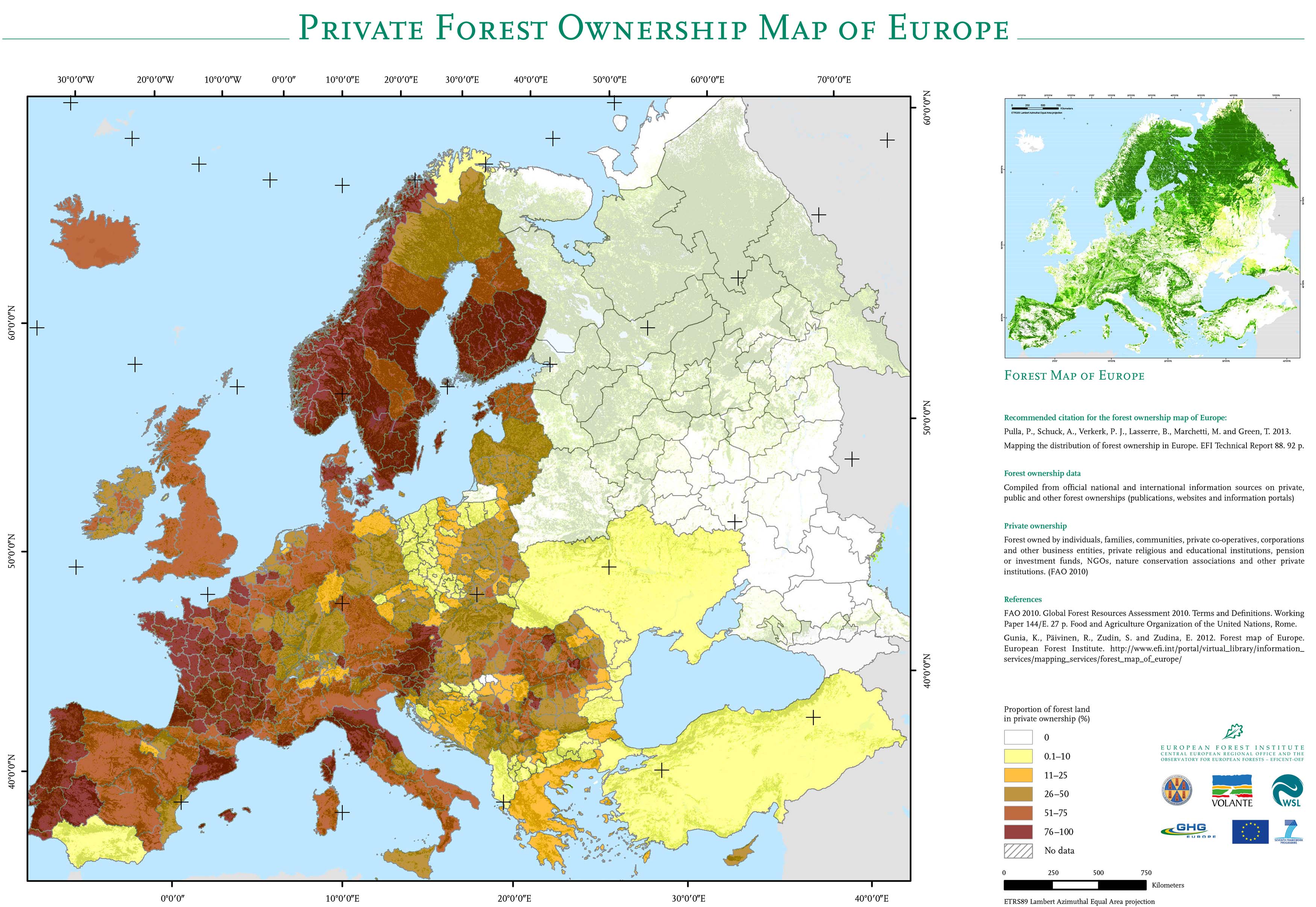Authors: Gerhard Weiss (EFI Forest Policy Research Network), Bernhard Wolfslehner (EFI), Ivana Zivojinovic (EFI Forest Policy Research Network).
European forests belong to around 16 million private and public forest owners. In the EU, about 60% of the forest area is privately owned and 40% public.
Public forests are owned by municipalities, regional or national governments. Private forests may include traditional, non-industrial types of private ownership including families, farms, rural commons, churches and aristocratic estates. Industrial private owners include forest industry companies, e.g. producing pulp and paper. There are also specific types that are not fully private nor public, such as commonly owned forests by local citizens or farm holdings that go back to historical ownership forms or are triggered by social movements.
Overall, the property sizes range from below one hectare to up to several millions of hectares. However, almost 90% of private forest holdings are smaller than 10 hectares, many are even much smaller. Income generated by forest use spreads to a large number of families and individuals in society (different from income generated from e.g. coal, oil or gas resources).
Due to the different historical, legal and social circumstances, patterns of public and private ownership vary greatly across Europe. For example, in Northern Europe, around 70% of the forests are privately owned, while in South East Europe around 90% are public. While private ownership clearly dominates in western European regions, it is the opposite in Eastern Europe (see Figure 1). The extent of property rights granted to owners by the specific national legal frameworks also differs strongly, with a gradient of a greater freedom for owners in forest management in Western European countries and more legal restrictions in Eastern Europe.
Societal and political developments, like structural changes in agriculture, urbanization, changes in lifestyles, as well as restitution and privatization after the 1989 fall of the Iron Curtain, and decentralization have led to changes in ownership patterns. When small farms are given up, the agricultural land is usually sold to other farmers, but forests are often kept in the family and may become owned by non-agricultural owners with urban lifestyles. The restitution of nationalized land to its former owners has been a major (and still ongoing) change in some Eastern European countries. The privatization of state forests is observed in the Baltic states.
Figure 1: Distribution of private and public ownership across Europe (red-strong private, yellow-strong public) (Pulla et al., 2013)
The goals and motivation of forest owners to manage their forests vary substantially. It depends on their forest size, their connection to their property, their preferences regarding economic, environmental and social values, and their flexibility to respond to market trends. The regional setting and infrastructure (e.g. is there a local industry using wood) is also likely to have a major effect. Together this all impacts on the way forests are managed and on the products and services which are provided to society.
While state forest owners generally actively manage their forests according to political, societal and business objectives, there is a wide variation in private forests, especially in smallscale forest ownership. This may range from active market participation to self-subsistence from forest products, keeping their forest as a reserve for family investments, to altruistic motives to no management at all. Especially owners of very small properties often lack the knowledge, skills, capacities and interest in forest management.
Another important aspect is the urbanization of owners – some have little or no connection to their forests,may live far away, or not even know that they are forest owners. This is true both for Western European countries (e.g. inherited forests owned by urban people) and for Eastern European countries where owners of restituted forests often lack bonds to their reacquired properties. In contrast to the existing good understanding of the behaviour of traditional forest holders, in most countries there is much less knowledge about other forest owner types with their specific motives and preferences.
The more fragmented forest ownership becomes the more important (and more difficult) it is to reach forest owners for common forest policy goals. Fragmentation often leads to economic inefficiency in forest management (higher harvesting and transaction costs), disincentives for investment in sustainable forest practices, and greater management problems related to the provision of ecosystem services, including wildlife, water, recreational opportunities and soil protection. However, joint management by private forest associations, forest certification initiatives and support by advisory services can address these disadvantages. The diversity of forest owners also represents a richness since a mosaic of management approaches can increase the resilience of forests, biodiversity at landscape level, and help to provide a more diverse set of forest ecosystem services.
